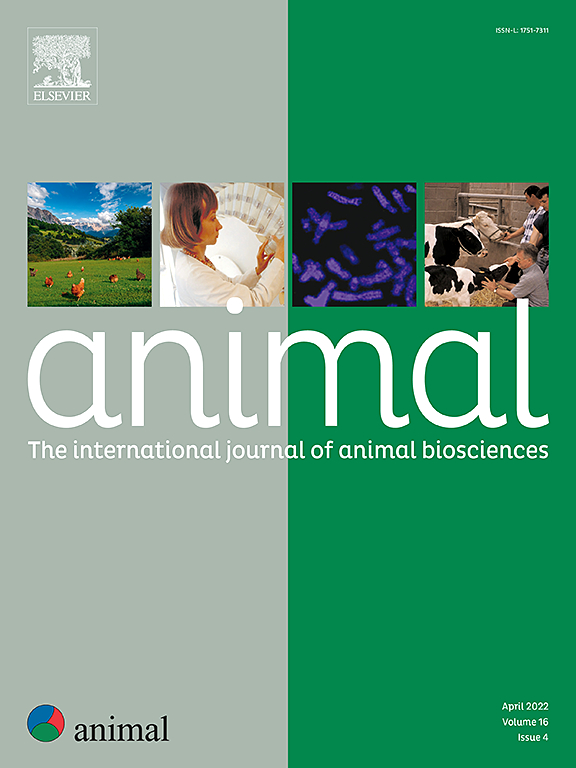Prediction of the digestibility and digestible energy content of hay for horses using an enzymatic degradability method
IF 4.2
2区 农林科学
Q1 AGRICULTURE, DAIRY & ANIMAL SCIENCE
引用次数: 0
Abstract
The nutritive value of forage for horses is closely dependent on the digestibility of organic matter (OMD), which is typically measured in vivo. Researchers have developed a variety of prediction methods to estimate the digestibility value of hay. In ruminants, pepsin-cellulase degradability, expressed as dry matter enzymatic degradability (dCS) and organic matter enzymatic degradability (dCO), is a commonly employed method for predicting OMD in forage types. The objective of this study was to evaluate the feasibility of predicting the dry matter digestibility (DMD), OMD, energy digestibility (ED) and digestible energy (DE) content of hay through enzymatic degradability or a combination of enzymatic methods with other chemical composition parameters. For that purpose, a database of 43 hays harvested in a temperate zone (32 natural grassland hays, five grass hays and six lucerne hays) was constructed from studies carried out at the French National Institute of Agricultural Research. The dCS and dCO of each hay type were determined, as well as their in vivo digestibility in horses. The range of OMD across the entire dataset was between 0.42 and 0.63, and the range of dCS cellulase digestibility was between 41.0 and 62%. The results demonstrated that there were no significant differences (P > 0.05) between the slopes of the models obtained for the various forage types. The models used for the prediction of DMD, OMD, ED and DE from dCS and dCO were characterised by R2 values between 0.87 and 0.91. The incorporation of chemical composition variables as independent variables into the prediction models did not result in a meaningful improvement in the model results obtained from dCS and dCO. The proposed models represent an alternative approach to the existing models for predicting the nutritive value and DE content of hay from their chemical composition.
用酶降解法预测马用干草的消化率和可消化能量含量
牧草对马的营养价值与有机质消化率(OMD)密切相关,这通常是在体内测量的。研究人员开发了多种预测方法来估计干草的消化率值。在反刍动物中,胃蛋白酶-纤维素酶可降解性,以干物质酶降解性(dCS)和有机质酶降解性(dCO)表示,是预测饲料类型OMD的常用方法。本研究旨在探讨通过酶降解率或酶法与其他化学成分参数相结合预测干草干物质消化率(DMD)、OMD、能量消化率(ED)和可消化能(DE)含量的可行性。为此目的,根据法国国家农业研究所进行的研究建立了一个数据库,其中包括在温带收获的43种干草(32种天然草地干草,5种草干草和6种卢塞恩干草)。测定各干草品种的dCS、dCO及其在马体内的消化率。整个数据集的OMD范围在0.42 ~ 0.63之间,dCS纤维素酶消化率范围在41.0 ~ 62%之间。结果表明,两组间无显著差异(P >;0.05),不同饲料类型的模型斜率之间存在显著差异。用dc和dCO预测DMD、OMD、ED和DE的模型的R2值在0.87 ~ 0.91之间。将化学成分变量作为自变量纳入预测模型并没有导致从dCS和dCO获得的模型结果有意义的改进。所提出的模型代表了从化学成分预测干草营养价值和DE含量的现有模型的替代方法。
本文章由计算机程序翻译,如有差异,请以英文原文为准。
求助全文
约1分钟内获得全文
求助全文
来源期刊

Animal
农林科学-奶制品与动物科学
CiteScore
7.50
自引率
2.80%
发文量
246
审稿时长
3 months
期刊介绍:
Editorial board
animal attracts the best research in animal biology and animal systems from across the spectrum of the agricultural, biomedical, and environmental sciences. It is the central element in an exciting collaboration between the British Society of Animal Science (BSAS), Institut National de la Recherche Agronomique (INRA) and the European Federation of Animal Science (EAAP) and represents a merging of three scientific journals: Animal Science; Animal Research; Reproduction, Nutrition, Development. animal publishes original cutting-edge research, ''hot'' topics and horizon-scanning reviews on animal-related aspects of the life sciences at the molecular, cellular, organ, whole animal and production system levels. The main subject areas include: breeding and genetics; nutrition; physiology and functional biology of systems; behaviour, health and welfare; farming systems, environmental impact and climate change; product quality, human health and well-being. Animal models and papers dealing with the integration of research between these topics and their impact on the environment and people are particularly welcome.
 求助内容:
求助内容: 应助结果提醒方式:
应助结果提醒方式:


